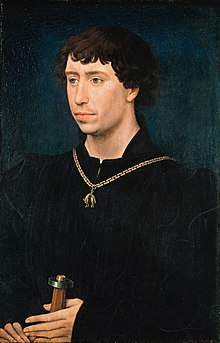Charles le Téméraire
| Charles the Bold | |
|---|---|

Rogier van der Weyden painted Charles the Bold as a young man in about 1460, wearing the collar of the Order of the Golden Fleece
|
|
| Duke of Burgundy | |
| Reign | 15 June 1467 – 5 January 1477 |
| Predecessor | Philip the Good |
| Successor | Mary |
| Born |
10 November 1433 Dijon, Burgundy |
| Died | 5 January 1477 (aged 43) Nancy, Lorraine |
| Spouse |
Catherine of France Isabella of Bourbon Margaret of York |
| Issue | Mary, Duchess of Burgundy |
| House | Valois-Burgundy |
| Father | Philip the Good |
| Mother | Isabella of Portugal |
Charles the Bold (French: Charles le Téméraire, Dutch: Karel de Stoute, 10 November 1433 – 5 January 1477), baptised Charles Martin, was Duke of Burgundy from 1467 to 1477. He was the last Duke of Burgundy from the House of Valois and is sometimes also known as Charles the Rash.
His early death at the Battle of Nancy at the hands of Swiss mercenaries fighting for René II, Duke of Lorraine, was of great consequence in European history. The Burgundian domains, long wedged between the growing powers of France and the Habsburg Empire, were divided, but the precise disposition of the vast and disparate territorial possessions involved was disputed among the European powers for centuries.
Charles the Bold was born in Dijon, the son of Philip the Good and Isabella of Portugal. Before the death of his father in 1467, he bore the title of Count of Charolais; afterwards, he assumed all of his father's titles, including that of "Grand Duke of the West". He was also made a Knight of the Golden Fleece just twenty days after his birth, invested by Charles I, Count of Nevers, and the seigneur de Croÿ.
Charles was brought up under the direction of Jean d'Auxy and early showed great application alike to academic studies and warlike exercises. His father's court was the most extravagant in Europe at the time, and a centre for the arts and commerce. While he was growing up, Charles witnessed his father's efforts to unite his far-flung and ethnically diverse dominions into a single state, and his own later efforts centered on continuing and securing his father's successes in this endeavor.
...
Wikipedia
